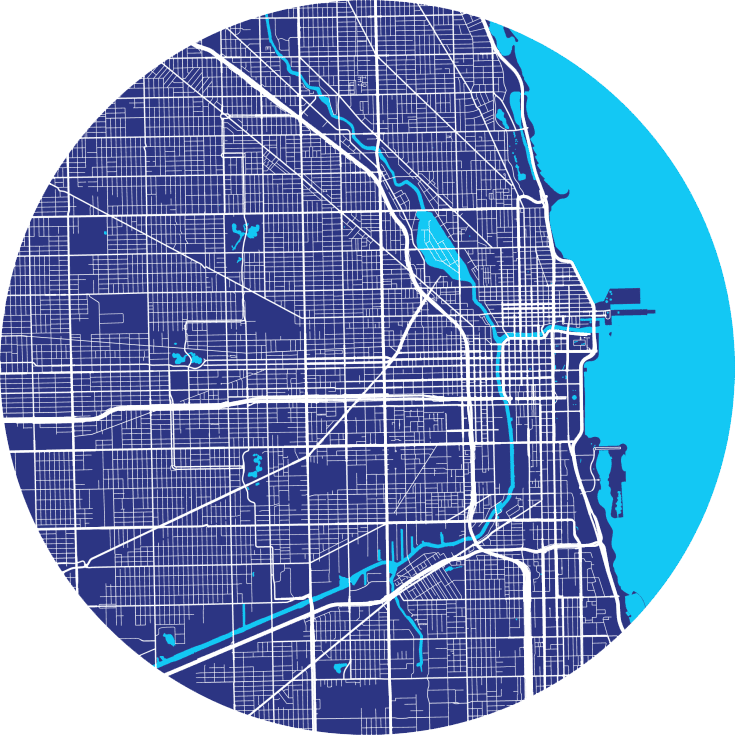When marketers and advertisers want to launch a campaign in specific geographic areas, they often use a concept known as Designated Market Areas (DMAs). DMAs are a powerful tool that helps businesses target their ideal audiences with precision, understanding the regions where they can reach the most potential customers through TV, radio, and digital platforms. This efficiency in targeting ensures that your marketing efforts are not wasted on irrelevant regions, boosting your confidence in your marketing strategies.
In this blog post, we’ll explain what a DMA is and how marketers use it. We’ll also give you an example of using a DMA by explaining which cities are part of the Chicago DMA. If you’re a business looking to advertise in Chicago and its surrounding cities, understanding the Chicago DMA is critical to maximizing your marketing efforts.
WHAT IS A DESIGNATED MARKET AREA (DMA)?
A Designated Market Area (DMA) refers to a region where the population receives the same television, radio, and sometimes even digital content. Nielsen, a media research company that analyzes consumer habits and viewership data to segment the United States into 210 designated market areas (DMAs), determines these areas. Each DMA typically centers around a major city or metropolitan area and encompasses the surrounding suburbs, influencing the media consumed by residents in the region.
The primary purpose of a DMA is to help marketers, advertisers, and media planners better target their campaigns geographically. When businesses know which DMA their audience is in, they can run more relevant ads on local TV stations, radio networks, and online platforms that cater to the same viewership or listener base.

WHAT ARE THE LARGEST AND SMALLEST DMAS?
In 2023, New York City was the largest DMA, with over 7.7 million homes, and Glendive, Montana, was the smallest, with 3,920 homes.

WHY ARE DMAS IMPORTANT IN MARKETING?
Understanding DMAs is crucial for marketers because they can design their campaigns based on where their target audience resides and consumes media. By focusing on a specific DMA, advertisers can:
Optimize their reach: Targeting a specific DMA ensures that your marketing efforts are concentrated in areas where your target audience is more likely to see or hear your ads. This precise targeting means you won’t waste ad dollars on irrelevant regions.
Tailor content: DMAs enable businesses to customize their messaging and creative content to match the local culture, language, or interests of those living in that area. For instance, running a special promotion during a significant event in Chicago (e.g., a Bears game) would resonate more with viewers in the Chicago DMA than in other markets.
Track effectiveness: Since DMAs are defined by media consumption patterns, it’s easier for businesses to measure how their campaigns perform in specific regions, allowing for better data-driven decision-making and budget allocation.
DESIGNATED MARKETING AREA BEST PRACTICES
Understand Your DMA
A Designated Marketing Area (DMA) defines the specific geographic region where your media will reach the highest concentration of potential viewers. However, it’s essential to recognize that cities nearby may fall into different DMAs, so your marketing message might not extend beyond certain regional boundaries.
Understanding the cities, counties, and towns that make up your DMA is the first step in making informed decisions about effectively targeting your audience.
Equally important is knowing the demographics within your DMA—age, income levels, cultural backgrounds, and buying behaviors all influence the kind of content that resonates best with your potential customers. Local research can be invaluable here, as it helps you tailor your campaigns to align with the unique characteristics of your DMA.
Build Your Budget For Your Target DMA
When planning your marketing budget, it’s essential to consider the size and cost of the DMA you’re targeting. Advertising costs typically increase in larger, more populous DMAs due to higher demand for media space and the potential reach of a broader audience. However, a larger audience doesn’t necessarily guarantee a better return on investment (ROI) if your message gets lost or doesn’t connect with the people most likely to convert. Focusing on a smaller, more defined DMA for businesses with more modest budgets can often yield better results. A concentrated effort in a smaller market allows you to optimize your resources and gain a stronger foothold. In contrast, spreading your budget too thin across a larger DMA can result in diluted impact and less engagement.
Position and Place Your Advertising According to Your Target DMA
After identifying the right DMA and allocating your budget, the next critical step is to strategically position and place your advertisements. You’ve invested time in understanding the unique traits of your DMA, so your advertising content should be crafted to match those insights. Whether you’re using digital ads, TV spots, or out-of-home placements, your messaging should reflect your audience’s preferences and pain points. Make sure the tone, visuals, and calls-to-action resonate with the cultural and regional sensibilities of the people within your DMA. Additionally, consider the media habits of your audience—whether they’re heavy consumers of local TV, frequent users of digital media, or more likely to engage with radio or print. Placing your ads in the proper channels can amplify your impact and maximize the effectiveness of your campaign.
THE CHICAGO DMA: WHAT CITIES ARE INCLUDED?
As our agency is located in Valparaiso, Indiana, let’s explore the Chicago DMA as an example.
The Chicago DMA is one of the largest DMAs in the United States and encompasses much more than just the city of Chicago. This DMA encompasses areas where local TV, radio, and media networks are based in Chicago, making it the ideal region for businesses to advertise if they aim to reach consumers in and around the city
Here are some of the
KEY CITIES AND TOWNS
within the Chicago DMA:

Chicago: The heart of the DMA and one of the most essential advertising markets in the U.S.
Aurora: One of the largest cities in Illinois, located west of Chicago.
Naperville: A large suburban city with affluent neighborhoods.
Evanston: A northern suburb, home to Northwestern University.
Joliet: A growing city southwest of Chicago.
Elgin: A city located northwest of Chicago with a diverse population.
Waukegan: A city along Lake Michigan to the north of Chicago.
Crown Point, Merrillville, and Valparaiso, Indiana: While outside Illinois, these cities and others in Northwest Indiana are part of the Chicago DMA.
Additionally, the DMA extends to other towns and rural areas within the Illinois-Indiana-Wisconsin Tri-State area, encompassing numerous suburbs and outlying regions.
For instance, a local car dealership in the Chicago DMA might run a TV ad during a Bears game, offering a special discount for viewers in the Chicago area. This targeted approach is more likely to resonate with the local audience and drive sales.
The Chicago DMA is a prime advertising location for businesses, not only because of its size but also due to its economic power. As one of the largest and most influential DMAs in the U.S., it offers unique opportunities for marketers to:
TARGET A LARGE, DIVERSE AUDIENCE:
With millions of residents in and around Chicago, advertisers have access to a broad demographic spectrum. These options include everyone from urban professionals in downtown Chicago to suburban families in areas like Naperville or Joliet. The diversity of this audience allows marketers to create highly targeted campaigns that resonate with various lifestyles and preferences.
LEVERAGE LOCAL MEDIA OUTLETS:
The Chicago DMA offers access to a robust local media network, including major TV stations such as WGN-TV, popular radio stations, and regional digital platforms. By utilizing these local outlets, marketers can position their ads where their specific Chicago-area audiences are most likely to consume content, increasing the chances of engagement and response.
CAPITALIZE ON CHICAGO’S ECONOMY:
As a leading metropolitan hub with a thriving economy, Chicago is an attractive market for businesses of all sizes, from local shops to national brands. The city’s economic strength and consumer spending power make it a high-value DMA for companies looking to expand their market share or launch new products.
MAXIMIZING YOUR MARKETING IMPACT WITH SMART DMA TARGETING
Understanding DMAs is crucial for any business looking to run effective marketing campaigns, and the Chicago DMA is no exception. Covering Chicago and its surrounding cities, this region offers a prime opportunity for businesses to reach millions of potential customers through well-targeted TV, radio, and digital ads. By leveraging the Chicago DMA, you can ensure your marketing dollars are spent efficiently and your message resonates with the right audience.
If you’re considering a campaign targeting the Chicago DMA or any other DMA, align your media strategy with local preferences and media consumption habits to get the best results.
In certain instances, advertisers may want to focus their efforts specifically on Northwest Indiana, rather than targeting the entire Chicago DMA. Thanks to advanced geo-targeting technologies, this is possible and can be a highly effective strategy. Businesses in cities like Hammond, Merrillville, Crown Point, Valparaiso, and Schererville can create marketing campaigns that target their local audience while excluding areas of Illinois, Wisconsin, and Michigan that may not be of interest to them. This type of geographic precision helps businesses avoid wasted ad spend. It ensures that their marketing budget is used to reach potential customers who are more likely to visit their locations.
For example, a local hardware store in Munster, Indiana, might want to promote a sale event. Rather than advertising to the entire Chicago DMA, which includes millions of people across multiple states, they can narrow their reach to just Northwest Indiana. By doing this, they ensure that homeowners primarily see their ads in Griffith, Dyer, and other nearby towns, who are more likely to shop at their stores.
Advertisers can achieve this precision across multiple platforms, including TV, digital display, and social media advertising. Whether you’re running a TV campaign targeting homes in Lake County and Porter County or a Google Ads campaign for users searching in Highland or Chesterton, targeting Northwest Indiana within the broader Chicago DMA ensures you reach the right customers while keeping your campaign local and relevant.
This strategy is ideal for businesses such as local contractors, medical practices, car dealerships, and other companies based in Northwest Indiana that primarily serve customers in the area and want to remain competitive with nearby markets in Illinois and Michigan. By narrowing down your audience, you reach the right people and boost engagement and return on investment (ROI) by focusing your marketing efforts where they matter most.

BRINGING IT ALL TOGETHER:
TARGET SMARTER, ADVERTISE BETTER
The Chicago DMA offers a wealth of opportunities due to its size, diversity, and economic influence. But just as important is the ability to narrow your focus within it. With tools that allow for hyperlocal targeting—such as digital geo-fencing or localized TV ad buys—businesses in Northwest Indiana and other surrounding areas can market more effectively without stretching their budgets thin.
Ultimately, leveraging DMA insights isn’t just about reaching more people—it’s about reaching the right people. By aligning your media strategy with both the broader reach of DMAs and the specificity of local targeting, your campaigns can deliver stronger results and a better return on investment.





